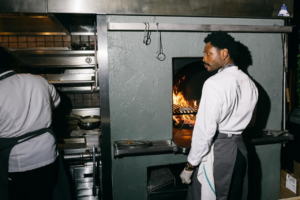Charlie Mitchell stands as a testament to the power of evolution. His journey from Detroit’s bustling kitchens to the refined corridors of Brooklyn Heights’ culinary scene represents more than a geographical shift—it embodies the transformative spirit of modern American gastronomy.
Walking into Clover Hill, housed in a historic Brooklyn Heights brownstone, one immediately senses the delicate balance Mitchell has struck between innovation and reverence for craft. The restaurant’s intimate setting serves as a stage for what Mitchell describes as “big flavors,” a philosophy that challenges the often restrained approach typical of fine dining establishments. Here, in this carefully curated space, Mitchell orchestrates a culinary performance that earned him a Michelin star merely eight months after opening—an achievement that speaks volumes about his distinctive vision.
Mitchell’s approach to cuisine reflects his own journey: bold yet thoughtful, ambitious yet grounded. At 24, he arrived in New York City, facing what he candidly describes as intimidation in an environment where culinary school graduates were “running circles around” their peers. Rather than allowing this to deter him, Mitchell transformed potential disadvantage into determination, immersing himself in cookbooks during rare moments of respite and approaching each day in the kitchen as an opportunity to refine his craft.
The evolution of Clover Hill under Mitchell’s stewardship mirrors the broader transformation of American fine dining. What began as a neighborhood establishment has blossomed into a destination restaurant, drawing guests who travel specifically for Mitchell’s meticulously crafted 15-16 course tasting menu. This transformation wasn’t merely about elevating the cuisine—it represented a fundamental shift in how fine dining spaces can serve as vessels for both cultural expression and culinary innovation.

Mitchell’s status as New York City’s first Black Michelin-starred chef and only the second in U.S. history carries profound significance, yet he approaches this milestone with characteristic humility and focus. “You don’t necessarily think that food can have the craziest impact all the time,” he reflects, before acknowledging the deeper resonance of his achievement: “Being able to do what I love and also be representative for my community is like a best case scenario.”
In Mitchell’s hands, each seasonal menu becomes a narrative, telling stories through carefully sourced ingredients and bold flavor combinations. His commitment to changing the menu quarterly ensures that Clover Hill remains not just relevant but revolutionary, pushing the boundaries of what fine dining can be while maintaining an unwavering commitment to excellence. This approach has not only earned critical acclaim but has also created a new paradigm for how ambitious young chefs can approach their craft—with equal measures of respect for tradition and coura
In the rarefied world of fine dining, where tradition often dictates trajectory, Charlie Mitchell’s meteoric rise at Clover Hill represents more than personal triumph—it marks a pivotal moment in culinary history. As New York City’s first Black Michelin-starred chef and only the second in the United States, Mitchell’s achievement transcends the boundaries of conventional success, reshaping the narrative of excellence in American gastronomy.
The transformation of Clover Hill under Mitchell’s stewardship reads like a masterclass in culinary evolution. What began as an intimate neighborhood establishment in Brooklyn Heights has blossomed into a destination that commands attention from global gastronomes. The catalyst for this metamorphosis arrived just eight months after opening, when the restaurant received its Michelin star—a testament to Mitchell’s unwavering commitment to excellence and his distinctive culinary voice.
“It really changed everything,” Mitchell reflects on the impact of the Michelin recognition, his words carrying the weight of profound transformation. The shift was immediate and multifaceted, affecting every aspect of the restaurant’s operations. The caliber of culinary professionals seeking positions in the kitchen elevated dramatically, while the dining room began attracting guests who approached their visits with newfound intentionality.
The evolution of Clover Hill’s clientele tells its own story of transformation. Where once local residents and casual diners might stumble upon the restaurant while searching for a meal in the neighborhood, the post-Michelin era has brought a more diverse and purposeful audience. International food enthusiasts now make pilgrimages to Brooklyn Heights, seeking out Mitchell’s innovative tasting menu with the same reverence usually reserved for long-established culinary institutions.
Yet perhaps most significant is how Mitchell’s success has redefined expectations within the industry itself. His achievement challenges long-standing assumptions about who can excel in fine dining and what excellence looks like in contemporary American cuisine. The restaurant’s evolution from neighborhood gem to culinary destination demonstrates that exceptional dining experiences can flourish outside traditional fine dining enclaves, provided there’s an unwavering commitment to quality and innovation.
Mitchell approaches this historic achievement with characteristic humility, focusing on the craft rather than the accolades. His dedication to maintaining exacting standards while pushing culinary boundaries has created a new paradigm for success in fine dining—one that values bold flavors and creative vision alongside technical precision. This balance has not only earned critical acclaim but has also created a more inclusive model for culinary excellence, inspiring a new generation of chefs to pursue their unique visions without compromise.
The transformation of Clover Hill under Mitchell’s leadership illustrates how breaking barriers in fine dining isn’t just about individual achievement—it’s about expanding the possibilities for excellence in American cuisine. Through his success, Mitchell has demonstrated that the future of fine dining lies not in adhering to conventional wisdom, but in having the courage to forge new paths while maintaining unwavering standards of quality.
In the refined world of fine dining, where subtlety often reigns supreme, Charlie Mitchell’s approach at Clover Hill stands refreshingly distinct. His culinary philosophy centers on a bold premise: in a 15-course tasting menu, every bite must leave an impression. This commitment to memorable flavors, coupled with a rigorous seasonal approach, defines Mitchell’s innovative contribution to contemporary American cuisine.
Four times a year, as the seasons shift across Brooklyn Heights, Mitchell orchestrates a complete transformation of Clover Hill’s menu. This quarterly reinvention isn’t merely a nod to seasonality—it’s a comprehensive reimagining of the dining experience. “Each menu and protein are so different that you have to do the whole cost breakdown all over again,” Mitchell explains, revealing the meticulous planning behind each evolution. This perpetual renewal keeps the kitchen team engaged and challenges them to push creative boundaries while maintaining the restaurant’s exacting standards.
The cornerstone of Mitchell’s culinary approach lies in his understanding of memory and taste. “Because it’s so much food, it’s hard to know what a person is going to remember at the end of the meal,” he reflects. This insight drives his commitment to creating dishes that resonate beyond the moment of consumption. Each of the 15-16 courses must justify its presence in the lineup, contributing to a narrative arc that builds throughout the dining experience.
Mitchell’s sophisticated approach to ingredient sourcing exemplifies the balance between ambition and pragmatism that characterizes modern fine dining. His incorporation of Japanese fish demonstrates a global perspective on flavor, while his attention to whole ingredient utilization speaks to a deeper understanding of sustainability and economics in restaurant operations. This duality—pursuing premium ingredients while maintaining careful cost management—reflects the complex realities of contemporary restaurant leadership.

The precision of Mitchell’s menu planning extends beyond flavor profiles to the minutiae of food costs and market fluctuations. “If you’re charging a certain amount of money, they can start to question why is this so expensive,” he notes, acknowledging the delicate balance between luxury dining and value perception. His solution lies in execution: “If you can highlight the food properly, then people won’t question it as much.” This philosophy underscores the importance of not just selecting premium ingredients, but showcasing them in ways that justify their inclusion.
Each menu at Clover Hill becomes a carefully orchestrated symphony of flavors, textures, and techniques. Mitchell’s commitment to bold, memorable tastes doesn’t preclude subtlety—rather, it ensures that every element serves a purpose in the larger composition. From the selection of seasonal vegetables to the preparation of premium fish, each component must contribute to the lasting impression that defines a truly exceptional dining experience.
Through this approach, Mitchell has created more than just a tasting menu—he’s developed a distinctive culinary voice that honors both innovation and tradition. His success demonstrates that in fine dining, true innovation often lies not in radical reinvention, but in the thoughtful evolution of established principles, guided by a clear vision and unwavering commitment to excellence.
In the realm of fine dining, where artistic vision often takes center stage, Charlie Mitchell’s approach to business management at Clover Hill reveals the critical intersection of culinary artistry and entrepreneurial acumen. His journey illustrates a fundamental truth often overlooked in culinary school: exceptional food alone doesn’t sustain a restaurant—it requires a sophisticated understanding of business dynamics and operational excellence.
The challenge of inflation in recent years has tested even the most established restaurants, but Mitchell’s response demonstrates the kind of adaptability essential for success in the modern culinary landscape. “The price of food is going up, but also what we see is people charging more for shipping, transportation… they’re like, ‘Oh, my gas is more expensive, so now your eggs are more expensive,'” Mitchell explains, highlighting the cascading effect of economic pressures on restaurant operations.
His approach to these challenges reveals a nuanced understanding of both economics and guest psychology. Rather than delivering impromptu “TED Talks” about rising costs during dinner service, Mitchell focuses on execution that justifies the price point. This strategic thinking extends to his sourcing decisions, exemplified by his experience with a Pennsylvania egg supplier. When prices escalated beyond sustainable levels, Mitchell made the difficult but necessary decision to adjust his supply chain rather than compromise the restaurant’s economic viability.
The complexity of managing a fine dining establishment becomes particularly evident in Mitchell’s approach to menu costing. Each quarterly menu revision requires a complete financial analysis, considering not just ingredient costs but also labor, waste, and market fluctuations. His experience with Japanese fish imports illustrates this dynamic perfectly—prices can surge unexpectedly due to weather conditions, requiring real-time adjustments to maintain profitability without compromising quality.
Mitchell’s approach to team building reveals another crucial aspect of restaurant management often overlooked in culinary conversations. With a kitchen team of just eight people, he understands that each hire must contribute not just skills but the right personality dynamics. “Throwing the wrong personality bombs into a small team is just like a bad idea,” he notes, emphasizing how staffing decisions impact both operational efficiency and workplace culture.
Perhaps most telling is Mitchell’s candid acknowledgment of learning “the hard way.” His experience with seemingly mundane aspects of operations, like the surprising cost of trash collection—”why is my bill like $1,000 a month just for trash?”—underscores the myriad details that demand attention in restaurant management. This willingness to engage with every aspect of operations, from waste management to labor costs, distinguishes successful restaurateurs from those who focus solely on culinary creation.
Through Mitchell’s experience, we see that excellence in fine dining requires more than culinary expertise—it demands a comprehensive understanding of business operations, human resources, and financial management. His success at Clover Hill demonstrates that in today’s competitive restaurant landscape, the path to culinary recognition must be paved with sound business practices and strategic thinking, all while maintaining the highest standards of gastronomy.
In the demanding world of fine dining, where perfection is expected nightly, Charlie Mitchell’s journey from sous chef to executive chef and partner at Clover Hill offers a masterclass in leadership evolution. His story challenges the traditional timeline of culinary advancement, demonstrating how authentic leadership often emerges from a combination of talent, humility, and an unwavering commitment to growth.
When the opportunity to helm Clover Hill presented itself, Mitchell faced a moment of profound self-reflection. “I didn’t necessarily think I was ready, to be honest,” he admits, acknowledging the weight of tradition in an industry where chefs typically spend 5-10 years training under mentors before taking the helm of their own kitchens. This candid self-assessment, rather than hindering his progress, became the foundation for his unique leadership approach.

The partnership with Clay, Clover Hill’s General Manager, illustrates Mitchell’s understanding of collaborative leadership. Their initial meeting focused not on menu concepts or culinary techniques, but on something more fundamental: alignment of vision and goals. This approach to partnership—prioritizing shared values over immediate operational concerns—has proved instrumental in the restaurant’s success. “We really didn’t talk about food too much,” Mitchell recalls, “we just wanted to make sure that our goals were aligned.”
Mitchell’s leadership style is marked by an unusual combination of confidence and humility. Even today, running one of Brooklyn’s most acclaimed restaurants, he maintains the learner’s mindset that characterized his early career. “I’m really someone who’s willing to ask for help,” he shares, noting how he continues to consult with chef friends about operational efficiencies and kitchen setups. This openness to learning, far from undermining his authority, strengthens it by creating an environment where continuous improvement is valued at all levels.
The daily rhythm of Mitchell’s leadership reveals a hands-on approach that defies the stereotype of the removed executive chef. Arriving at 11:30 AM after checking in with the morning team, he prioritizes time in the kitchen—”I just like to exist with the cooks and get in there and prep and see what’s going on”—over administrative tasks. This presence on the line isn’t merely about supervision; it’s about maintaining the direct connection to craft that initially drew him to cooking.
His approach to team building reflects a sophisticated understanding of kitchen dynamics. In an industry often characterized by high turnover, Mitchell takes a measured approach to hiring, preferring to operate understaffed temporarily rather than risk disrupting team chemistry with the wrong hire. “Throwing the wrong personality bombs into a small team is just like a bad idea,” he notes, demonstrating how leadership in fine dining requires balancing immediate operational needs with long-term cultural considerations.
Through Mitchell’s journey, we see how modern culinary leadership transcends traditional hierarchical models. His success at Clover Hill proves that effective leadership in fine dining isn’t just about technical expertise or creative vision—it’s about creating an environment where excellence can flourish through continuous learning, authentic collaboration, and unwavering commitment to craft. This approach not only elevates the dining experience but also sets a new standard for leadership in the culinary world.
In the competitive landscape of fine dining, where talent alone rarely guarantees success, Charlie Mitchell’s path to culinary excellence offers invaluable insights for aspiring chefs. His journey from Detroit to Michelin stardom in Brooklyn Heights illuminates the essential elements that transform culinary ambition into sustained achievement.
At the foundation of Mitchell’s success lies an unwavering dedication to craft. “Focus on the food,” he emphasizes, positioning technical mastery as the bedrock upon which all other achievements are built. This fundamental principle guided his early career in New York City, where at age 24, he found himself competing with culinary school graduates who seemed to possess advantages he lacked. Rather than viewing this as an insurmountable obstacle, Mitchell transformed his perceived disadvantage into motivation, immersing himself in cookbooks during rare moments of respite and approaching each day in the kitchen as an opportunity for growth.
The role of curiosity in Mitchell’s development cannot be overstated. “Be curious, ask a lot of questions,” he advises, noting how this approach should extend beyond the kitchen to encompass the business aspects of restaurant operations. His willingness to seek knowledge from dining room staff, ownership, and anyone involved in the business side of operations demonstrates how comprehensive understanding contributes to overall success. This intellectual humility, rather than diminishing his authority, has enhanced his effectiveness as a leader and innovator.
Perhaps most striking is Mitchell’s emphasis on commitment in an industry known for its challenging conditions. “I really committed to doing this a long time ago,” he reflects, acknowledging the reality of “long days, long hours as a cook where you don’t make a lot of money and your chefs aren’t always nice to you.” This clear-eyed recognition of industry challenges, coupled with unwavering dedication, distinguishes those who succeed from those who merely aspire.
The balance between creative vision and operational pragmatism emerges as another crucial element in Mitchell’s success formula. At Clover Hill, this manifests in his approach to menu development, where artistic ambition must align with business sustainability. His quarterly menu changes demonstrate how creativity can flourish within practical constraints, producing innovations that are both culturally significant and commercially viable.

Mitchell’s journey also highlights the importance of timing and self-belief in career development. When offered the opportunity to lead Clover Hill, despite feeling not entirely ready, he embraced the challenge with a pragmatic philosophy: “If I’m not going to bet on myself, then you can’t expect someone else to.” This moment of decision illustrates how success often requires stepping into opportunities before feeling fully prepared, trusting that dedication and continuous learning will bridge any gaps in experience.
The synthesis of these elements—technical mastery, intellectual curiosity, unwavering commitment, and balanced vision—creates a framework for culinary success that transcends mere recipe reproduction or technique execution. Mitchell’s approach demonstrates that excellence in fine dining requires not just skilled hands but an engaged mind, resilient spirit, and strategic perspective. His experience proves that while the path to culinary achievement demands sacrifice and dedication, it also offers the profound satisfaction of creating experiences that resonate with diners while advancing the art of gastronomy.
**Legacy in the Making: Charlie Mitchell’s Impact on Modern Fine Dining**
In the ever-evolving landscape of fine dining, where success stories often follow predictable trajectories, Charlie Mitchell’s journey at Clover Hill stands as a compelling testament to the transformative power of authentic vision and unwavering dedication. His ascent from Detroit kitchens to Michelin-starred excellence in Brooklyn Heights not only reshapes traditional narratives about achievement in haute cuisine but also establishes a new paradigm for culinary leadership in the modern era.
Mitchell’s impact extends far beyond the confines of his intimate Brooklyn Heights establishment. His approach to fine dining—characterized by bold flavors, seasonal innovation, and meticulous attention to detail—demonstrates how contemporary restaurants can maintain exacting standards while breaking free from conventional constraints. Through his quarterly menu transformations and commitment to memorable dining experiences, Mitchell has proven that culinary excellence need not be bound by tradition to achieve recognition at the highest levels.
Perhaps most significant is how Mitchell’s success challenges and enriches the very definition of fine dining leadership. His willingness to learn “the hard way,” coupled with an uncommon openness about the challenges of restaurant management, provides an invaluable roadmap for aspiring chefs. From tackling the surprising complexities of waste management to navigating the delicate balance of team dynamics in a small kitchen, Mitchell’s experiences offer practical insights while maintaining the aspirational quality that defines truly great culinary achievements.
The evolution of Clover Hill under Mitchell’s stewardship illustrates the potential for transformation when technical expertise meets entrepreneurial acumen. His ability to adapt to market pressures while maintaining unwavering standards of quality demonstrates how modern fine dining establishments can thrive amid economic challenges. This balance—between artistic vision and business sustainability—sets a new standard for restaurant leadership in an increasingly competitive industry.

As New York City’s first Black Michelin-starred chef and only the second in U.S. history, Mitchell’s achievements resonate beyond personal success to inspire broader change in the culinary world. Yet his focus remains steadfastly on the fundamentals: exceptional food, memorable experiences, and the nurturing of talent within his team. This grounding in craft, combined with an innovative spirit and authentic leadership style, creates a legacy that will influence the next generation of culinary professionals.
In Mitchell’s journey, we find a blueprint for modern culinary excellence—one that values both tradition and innovation, technical mastery and emotional intelligence, personal achievement and community impact. His success at Clover Hill proves that the future of fine dining lies not in rigid adherence to established norms but in the courage to forge new paths while maintaining unwavering commitment to quality and craft.
As the culinary world continues to evolve, Mitchell’s example stands as a beacon for aspiring chefs and restaurateurs, demonstrating that truly transformative success comes not just from mastering techniques or collecting accolades, but from maintaining authenticity while pursuing excellence in every aspect of restaurant leadership.


